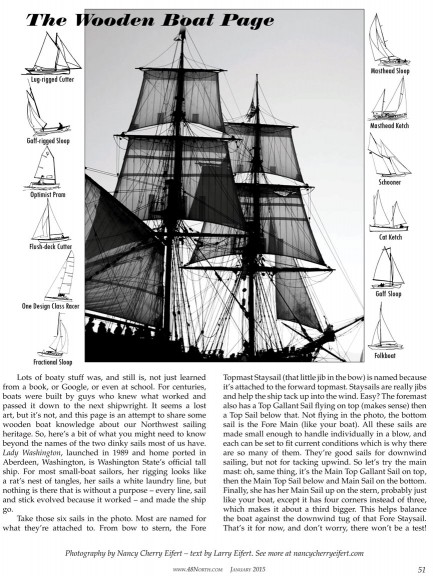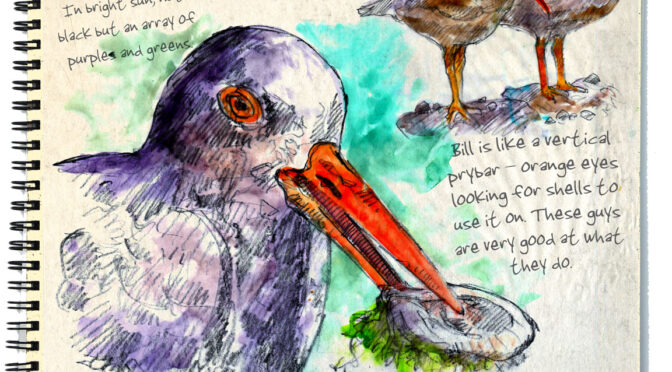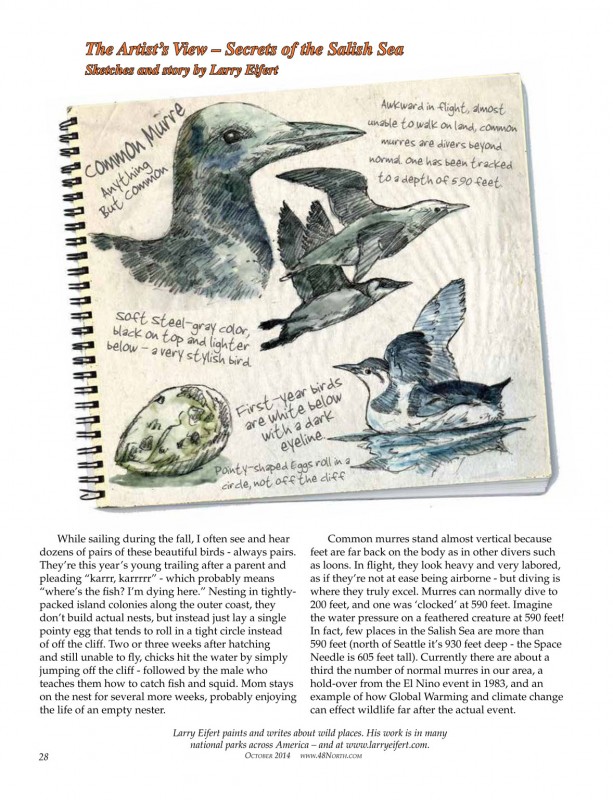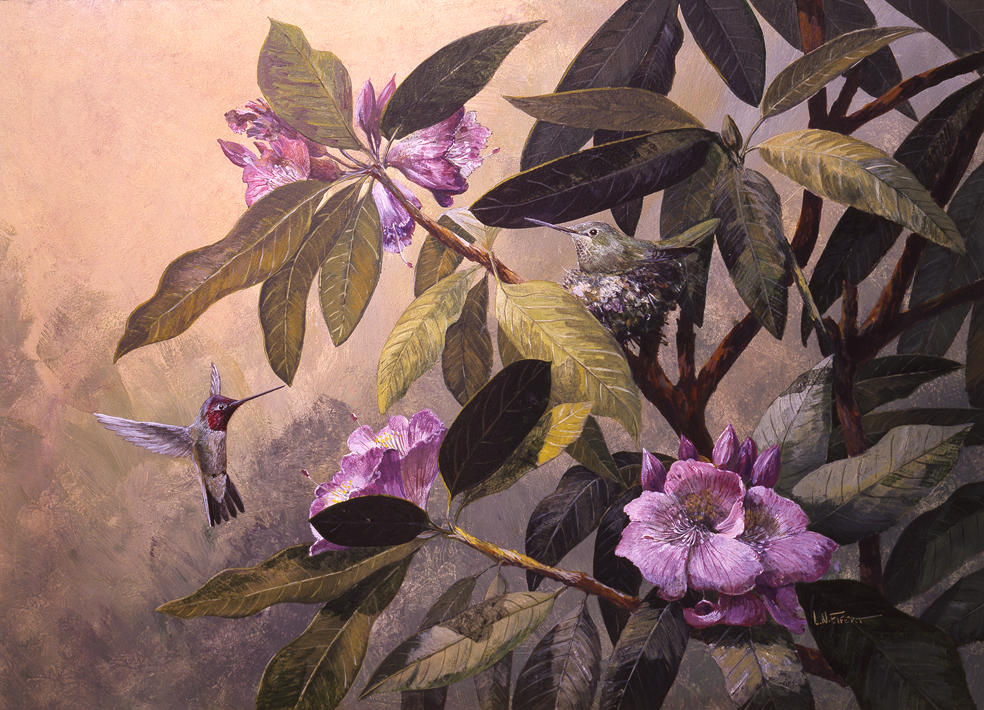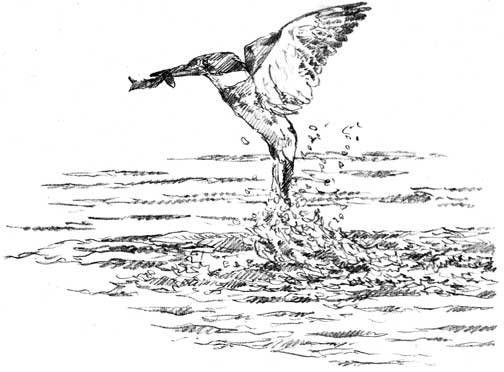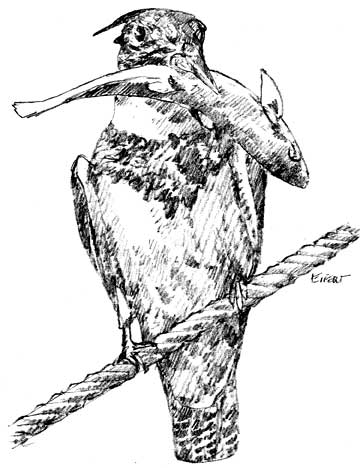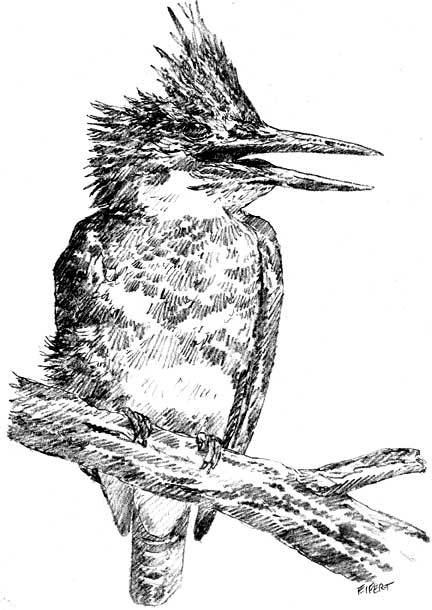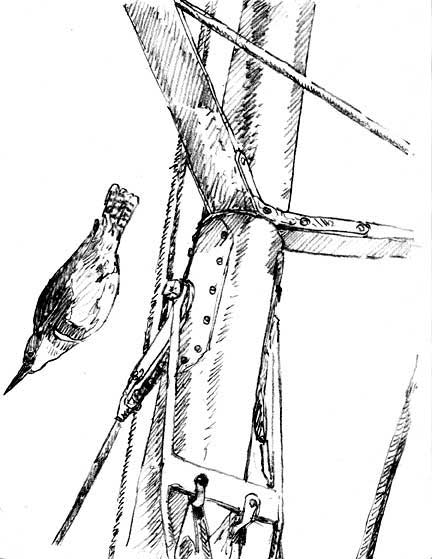
Cover art and story – 48 North Magazine, September 2009. (48 North is the premier sailing magazine for the Pacific Northwest) This month features my painting of our little sloop, Sea Witch, sailing by downtown Port Townsend. They also featured my short story about herring balls.
Sorry if this is a long entry, but the story’s a good one and I’ve shortened it abit.

Fish Balls
by Larry Eifert
An amazingly nice afternoon! Get the sail covers off Sea Witch. Back her out. Head down the channel and out into Port Townsend Bay. Then, get the sails up, sheet’r home. And away we went to the north out into Admiralty Inlet, watching the freighters and navy ships tooing and frowing. A warm northwesterly wind was gently spilling out from the hills of Port Townsend and into the bay. It was tee-shit weather.
We hadn’t made it to the Mid Channel Bank when ahead we could see a great mass of moving birds. Actually, there were several masses of birds, all wheeling and spinning, diving and making a ruckus. “Herring balls” we both said at the same time as we nodded in unison. The birds were going crazy. About fifty glaucous-winged gulls were in each group, and more flying in as fast as they could from other areas nearby. Cormorants, rhino auklets, a few pigeon guillemots and even a bunch of mergansers were all bobbing about, diving, grabbing at others nearby and generally making a “happening” as I use to say 40 years ago. The gulls couldn’t dive very deeply, being very buoyant-birds, so they just gave it their best, plunging from about five feet into the water and grabbing at nothing. “Mine, mine, mine, mine!” they all yelled continuously. It was a riot, and as we approached, none of the birds seemed to care we were there. Then a slow, huge and powerful swirl of water nearby showed something else was going on below the surface. Unseen until now, a sea lion was there as well, circling up from below to concentrate the herring ball close to the surface. A 650 lb, 8 foot-long sea lion can make an impression on everyone, including tiny fish. It was intense – and this was just one of about six riots of wildlife within our view.

Well, I knew what was going on, but maybe you don’t, so here’s what these big events were all about.
Pacific herring are little fish, and if you’re a little fish, you can gain odds for prolonging your life if you stick together. A bunch of little fish can become a very big fishy thing if you hang out together – think teenagers hanging out! One teenager – no big deal, but a half a million of them and you get Woodstock. That’s the herring teenager’s idea too, but there are lots of bigger critters out there trying to dine on them. There’s not a moment’s peace. And while sticking together can increase your odds of individual survival, it also announces to everyone where you’re hanging out.
Most Puget Sound herring spawn from late January to early April, depositing transparent sticky eggs on eelgrass and marine algae in shallow water, mostly in quiet bays and estuaries. Each female deposits between 20,000 and 40,000 eggs a year, and it’s these sheer numbers that insure the herring’s survival. These sticky eggs cling to eelgrass stems, and, after about 14 days, hatch into small transparent larvae about a half-inch long. The little critters are at the mercy of currents as they drift about, but the larvae that survive grow until after 3 months when they are about 1½” long, when they metamorphose into adult fish, eventually growing to become six to nine inches long. Think sardines in that square little can, but bigger. Most of us know Pacific herring from bait shop freezers, where we see them lined up in blue Styrofoam trays.
On the second or third year, herring normally return to their original spawning grounds. Unlike salmon, spawners don’t normally die but continue to spawn in successive years, although most don’t make it past five years of age. A few may live to the ripe old age of fifteen. However, it’s been estimated that, for every 10,000 herring eggs, ONE adult will live long enough to return to spawn, such is the level of predation on these little fish. In Puget Sound, we, as the dominate prey species, have decided that spawning herring make up 18 different “management stocks” (because we, as herders of the world’s critters need to count all this stuff so we know how much to “take”). In the past, herring have been caught for food, then caught and ground up for oil and pet food. Some of the eggs are used (in Canada) as high-end gourmet food for Asian markets. The reality of it is that the many seabirds, marine mammals and larger fish species have a greater need and eat these important little fish to help them survive. Fewer orcas these days? Well, it might be that a bunch of us dropped our anchors in those wonderfully quiet back bays where eel grass beds live, our 45lb Danforths tearing up the bay’s bottom and depriving herring of good quality habitat for them to lay their eggs. Or, more likely, shoreline trophy home owners have altered the spawning grounds off their front yards by adding elaborate stone walls and lawns that use chemicals that then run off into the nearby waters – killing the ecosystem they spent zillions of dollars to live next to. Fewer herring means less food for salmon, an important food for orcas. Fewer herring also means less food for orcas, too, which catch them the same way seals do. In Puget Sound, 60-70% of the herring are eaten by larger critters each year, and the numbers of herring is decreasing each year. Get the picture?
We watched the herring action for awhile longer as we sailed past, then headed over to the next ball of birds and fish. Out of that cloud of wheeling and screaming gulls, a lone rhinoceros auklet flew by at top speed holding a 3” flapping herring in its bill. You could almost imagine the bird’s thoughts of “I got mine, now I’m getting out of this party as fast as my little black wings can carry me.”

Well, so what? So what’s the big deal with watching a bunch of birds? To me, it’s a matter of the quality of life. Sure it was a pleasant day for a sail. The scenery was beautiful, the company wonderful, the experience memorable – but experiencing the herring balls made it much more. We had watched nature at a very close range, beyond the beach and parking lots, beyond the signs that say: Wildlife Viewing Area. Out here on the waters of Puget Sound, a daysail can turn into a real experience if you just look for it. Many sailors might have just sailed by, maybe only worried their sails might get a dab of bird doo on them. Some wouldn’t have even noticed, for it seems that many of us have diminished attentions these days to the natural world around us. We spend most of our lives chained indoors, watching nature on monitors or TVs, watching movies about penguin marches or watching others do what we once took for granted we’d do ourselves which is to seek outdoor experiences. Well, I’m telling you those experiences are still there, still waiting for us, and still exciting to see when we let them into our lives. I’d like to think that, with a good-old recession now altering our grandiose lifestyles a bit, we may begin to think about returning to the old ways of enjoying ourselves. Get outside, get in a boat, get your eyes open again and see a few things. You might find you like yourself more for these experiences.
If you want more of this stuff, you can click here to go to our index page of more published stories.
Check out 48-North magazine completely online.
Link here to the same story on our website, larryeifert.com.
If you’d like to see why I write about this ol’ boat of ours, here’s more about Sea Witch.
Or, send us an email to opt in or out of our email family – or just ‘talk’ with us.
***previous*** — ***next***

